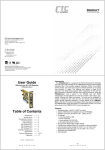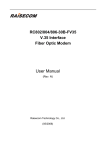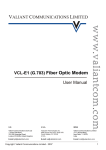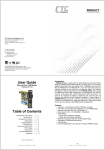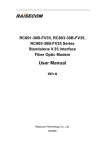Download Raisecom RC802-240B User manual
Transcript
Beijing Raisecom Science & Technology Co., Ltd. http://www.raisecom.com RC802-30B-FV35 Series N×64K V.35 Interface Fiber Optic Modem User Manual Beijing Raisecom Science & Technology Co., Ltd. -1- Beijing Raisecom Science & Technology Co., Ltd. http://www.raisecom.com CONTENTS CHAPTER 1. RC802-30B-FV35 INTRODUCTION .....................4 1.1 DESCRIPTION .....................................................................................................................4 1.2 PRODUCT SPECIFICATIONS.......................................................................................................4 1.2.1 Fiber Optic Interface Specification..................................................................................4 1.2.2 V.35 Interface Specification..............................................................................................5 1.2.3 V.35 Signal Bandwidth Engrossment of Timeslots at E1 Fractional Mode ......................5 1.2.4 Power Consumption .........................................................................................................5 1.2.5 Ambience..........................................................................................................................5 1.3 EQUIPMENT INTERCONNECTION ..............................................................................................6 CHAPTER 2. RECOMMENDED CONNECTION TYPE ......6 2.1 PRECAUTIONS BEFORE CONNECTION ......................................................................................6 2.1.1 Three Types of Timing Resource.......................................................................................6 2.1.2 Compatibility....................................................................................................................6 2.2 BASIC CONNECTION TYPE .......................................................................................................6 2.2.1 Point-to-point Fractional Mode, ‘Master Clock – Slave Clock’ Topology.......................7 2.2.2 Point-to-point Fractional Mode, ‘Terminal Clock – Slave Clock’ Topology....................7 2.2.3 Point-to-point Transparent Mode, ‘Master Clock – Master Clock’ Topology..................7 EXTENDED CONNECTION TYPE .....................................................................................................8 CHAPTER 3. PREPARATION..........................................................................9 3.1 DESCRIPTION OF THE FRONT PANEL ........................................................................................9 3.1.1 Definition of the Indicators ..............................................................................................9 3.1.2 V.35 (DCE) Interface........................................................................................................9 3.1.3 Fiber Optic Interface .....................................................................................................10 3.2 DIP-SWITCH SW1 SETUP ON THE BOTTOM PANEL.................................................................10 3.2.1 The 1st ~ 5th Bit: V.35 Interface Bandwidth Setup...........................................................10 3.2.2 The 6th Bit: V.35 Bandwidth Control Option .................................................................. 11 3.2.3 The 7th and 8th Bits: Timing Resource Option ................................................................12 3.2.4 The Factory Default Setup of SW1: All OFF ..........................................................12 3.3 DIP-SWITCH SW2 SETUP ON THE BOTTOM PANEL ...........................................................13 3.3.1 The 1st ~ 6th Bits Definition ............................................................................................13 3.3.2 The 7th and 8th Bits: Vacant ............................................................................................14 3.3.3 The Factory Default Status of SW2: All OFF.................................................................14 CHAPTER 4. INSTALLATION AND TROUBLESHOOTING ..........................................................................................14 -2- Beijing Raisecom Science & Technology Co., Ltd. http://www.raisecom.com 4.1 CAUTIONS BEFORE APPLYING THE POWER SUPPLY ...............................................................14 4.2 CONNECTION DIAGNOSIS ................................................................................................14 4.3 FAULT-PASS-THROUGH FUNCTION ...................................................................................15 4.4 FAQS ...............................................................................................................................15 -3- Beijing Raisecom Science & Technology Co., Ltd. http://www.raisecom.com Chapter 1. RC802-30B-FV35 Introduction RC802-30B-FV35 series modular N*64kbps V.35 interface fiber optic modems are devices that are deployed to transmit V.35 signals on fiber optics. They are widely used equipment in constructing Wide Area Networks, and provide solutions for connecting Routers distantly. RC802-30B-FV35 supports remote management function, and it can be deployed at the local site to realize the remote management. 1.1 Description ● ● ● ● ● ● ● ● Complies with G.704 frame definition,realize bandwidth control on V.35 interface Provides three clock mode: master clock、slave clock、V.35 terminal clock Fault pass function: transfer alarms of receiving and transmitting E1 side to DCD、CTS signal of V.35 interface Optional reciprocal relations between data and clock of transmitting and receiving at V.35 interface are provided to conform to different branded routers. Transparent E1: data rate is 2048Kbps on V.35 interface Fractional E1: data rate can be configured N×64Kbps(N=1~31) When the devices work in pair by fractional E1 mode,they enable remote loop-back on E1 channel When the devices work in pair by fractional E1 mode,the bandwidth of remote site will follow local site automatically 1.2 Product Specifications 1.2.1 Fiber Optic Interface Specification Bit rate: 100Mbps Line code: 4B5B Fiber connecter: SC Optical Transmission of dual-strand fiber: Transmit power: ≥-5 dBm Receiving sensitivity: ≤-35 dBm Transmit Wavelength: 1310nm Distance: >40km -4- Beijing Raisecom Science & Technology Co., Ltd. http://www.raisecom.com 1.2.2 V.35 Interface Specification Physical characteristics: Connector type: Working mode: Interface bit rate: Complies with V.35 interface standard HDB26 female connector DCE V.35 interface bit rate is N×64Kbps(N=1~31)at E1 fractional mode; V.35 interface bit rate is 2048Kbps at E1 transparent mode 1.2.3 V.35 Signal Bandwidth Engrossment of Timeslots at E1 Fractional Mode The engrossment of timeslots in PCM31 In PCM31, N ≤ 31, No. 0 timeslot is taken up by the system. V.35 BANWIDTH TS[0] TS[1] …… TS[N] …… TS[31] The engrossment of timeslots in PCM30 In PCM30, N ≤ 30, No. 0 and No. 16 timeslots are taken up by the system. N shall be counted from No. 1 timeslot, and No. 16 timeslot shall be skipped if N is larger than 16. V.35 BANWIDTH TS[0] TS[1] …… TS[16] 1.2.4 Power Consumption Power Consumption: ≤ 5W 1.2.5 Ambience Working Temperature: 0 ~ 45℃ Relative Humidity: 5%~90% no condensing -5- …… TS[N+1] …… TS[31] Beijing Raisecom Science & Technology Co., Ltd. http://www.raisecom.com 1.3 Equipment Interconnection When connecting with other optical multiplexers, it is required to follow the instructions below. Otherwise, link faults or abnormal data transmission may occur. Chapter 2. Recommended Connection Type 2.1 Precautions before Connection 2.1.1 Three Types of Timing Resource Master Clock Mode: The timing resource is provided by the crystal oscillator inside the equipment, also called Internal Clock. Slave Clock Mode: The timing resource is provided by recovering the clock from the fiber optic receiving link, also called Restoring Clock. Terminal Clock Mode: The timing resource is provided by the DTE, also called System Clock. 2.1.2 Compatibility If RC802-30B-FV35 is connected with G.703 interface fiber optic modem, and then connected with other brand name E1 fractional mode equipment (i.e. V.35 to fractional E1 interface converter, E1 interface Router); or such equipment as DXC and MUX is serially connected in the E1 link, the following requirements shall be noticed. 1. PCM30/31 format must be the same 2. The status of CRC enable/disable function must be the same 3. The V.35 signal bandwidth engrossment of G.704 frame pattern must match 4. Ensure that there is only one timing resource in the whole link. Other PCM equipment shall be configured to Slave Clock Mode (following the link clock). 2.2 Basic Connection Type The connection topologies introduced in this part is only for user reference. Users are advised to design and deploy the most appropriate topology according to their specific environment. -6- Beijing Raisecom Science & Technology Co., Ltd. http://www.raisecom.com 2.2.1 Point-to-point Fractional Mode, ‘Master Clock – Slave Clock’ Topology When connecting Routers or other V.35 interface equipment point to point, Routers shall work as DTE. For the convenience of installation and test, it is advised to set the local modem ‘Master Clock Mode’, and remote modem ‘Slave Clock Mode’. That is, the timing resource is from the local modem. Master Clock (Timing Resource) Optical Fiber Slave Clock RC802-30B-FV35 RC801-30B-FV35 V.35 DTE wire V.35 DTE wire Router Router 2.2.2 Point-to-point Fractional Mode, ‘Terminal Clock – Slave Clock’ Topology When the remote DTE must follow the timing resource of local DTE (the TX Clock is Internal Clock in local DTE), it is advised to set the local RC802-30B-FV35 Terminal Clock, and remote RC801-30B-FV35 Slave Clock Mode. Terminal Clock Optical Fiber Slave Clock RC802-30B-FV35 RC801-30B-FV35 V.35 DTE wire V.35 DTE wire Router Router (Timing Resource) 2.2.3 Point-to-point Transparent Mode, ‘Master Clock – Master Clock’ Topology When working at Transparent E1 Mode, both sides equipment can be set to Master Clock Mode. -7- Beijing Raisecom Science & Technology Co., Ltd. http://www.raisecom.com The bit rate at V.35 interface will be 2048kbps. Master Clock Optical Fiber Master Clock RC802-30B-FV35 RC801-30B-FV35 V.35 DTE wire V.35 DTE wire Router Router Extended Connection Type RC802-30B-FV35 cannot be interconnected with other brand name V.35 interface fiber optic modems. However, users can adopt RC800-30B series E1 fiber optic modem, which will convert the optical signals to G.703 compliant E1 electrical signals, and then, connect with a V.35 to fractional E1 interface converter. Users can adopt Raisecom series interface converters such as RC903-V35FE1 and RC904-V35FE1, and also other brand name interface converters. Optical Fiber RC802-30B-FV35 E1 RC801-30B RC903-V35FE1 V.35 DTE wire V.35 DTE wire Router Router If deploying E1 interface Router at the remote site, RC801-30B E1 fiber optic modem can be adopted at the remote site as the following diagram. It is advised that if the Router is set to Master Clock, then the RC802-30B-FV35 at local site shall be set to Slave Clock. Optical Fiber RC802-30B-FV35 RC801-30B-FV35 RC801-30B V.35 DTE wire E1 Router WAN port = E1 Router WAN port = V.35 -8- Beijing Raisecom Science & Technology Co., Ltd. http://www.raisecom.com Chapter 3. Preparation Please read this chapter carefully before installing the equipment. 3.1 Description of the Front Panel DCE TX RX ALM PWR 3.1.1 Definition of the Indicators PWR. Power supply indicator (green): Steady on, built-in power works in good condition. ALM. Alarm indicator (red): Local receiving signal error alarm, (The status is ON) Remote receiving signal error alarm, (The status is FLASH) ALM indicators are used to check the E1 signals that are generated from the optical receiving link. In the extended connection solutions in Chapter 2.3, if errors occur at the remote transmit and receive link, then ALM can be used to indicate this alarm. If users do not adopt Raisecom V.35 to fractional E1 interface converter (i.e. RC903-V35FE1), then the remote alarm is invalid. 3.1.2 V.35 (DCE) Interface V.35 interface adopts V.35/HDB26 Female connector. It can be connected by standard DTE cable. The definitions of the pins are as follows: Pin Name Input/Output Pin Number Chassis Ground — CGND - 1 Signal Ground — GND - 7 Receive Data (A) — RD(A) O 3 Receive Data (B) — RD(B) O 21 Receive Timing (A) — RCK(A) O 17 Receive Timing (B) — RCK(B) O 25 Send Data (A) — TD(A) I 2 Send Data (B) — TD(B) I 11 Send Timing (A) — TCK(A) O 15 Send Timing (B) — TCK(B) O 23 Terminal Timing (A) — SCTE(A) I 24 Terminal Timing (B) — SCTE(B) I 16 -9- Beijing Raisecom Science & Technology Co., Ltd. http://www.raisecom.com Request to Send — RTS I 4 Clear to Send — CTS O 5 Data Set Ready — DSR O 6 Data Carrier Detect — DCD O 8 Data Terminal Ready — DTR I 20 I --- input; O --- output. 3.1.3 Fiber Optic Interface For the dual-strand models, the fiber optic interface is DSC/PC. TX stands for optical signal output (transmit); RX stands for optical signal input (receive). 3.2 Dip-switch SW1 Setup on the Bottom Panel Bottom Panel Back Panel Interface SW1 V.35 Interface SW2 Fiber Optical Interface The dip-switch SW1 on the bottom panel must be set up before use. 1st ~ 5th bit: V.35 interface bandwidth setup 6th bit: bandwidth master control/slave control setup 7th ~ 8th bit: timing resource option ON OF 1 2 3 4 5 6 7 8 3.2.1 The 1st ~ 5th Bit: V.35 Interface Bandwidth Setup V.35 bit rate is N*64kbps (N=1~31) when working at fractional E1 mode; V.35 bit rate is 2048kbps when working at transparent E1 mode. These 5 bits of the dip-switch are actually representing the binary code of the N value. When N is configured to 0, RC802-30B-FV35 is working at transparent E1 mode. 1st bit 2nd bit 3rd bit 4th bit 5th bit Bandwidth (bit/s) 0 0 0 0 0 2048K (transparent E1 mode) 0 0 0 0 1 1×64K=64K (minimum bandwidth) 0 0 0 1 0 2×64K=128K 0 0 0 1 1 3×64K=192K - 10 - Beijing Raisecom Science & Technology Co., Ltd. http://www.raisecom.com 0 0 1 0 0 4×64K=256K 0 0 1 0 1 5×64K=320K 0 0 1 1 0 6×64K=384K 0 0 1 1 1 7×64K=448K 0 1 0 0 0 8×64K=512K 0 1 0 0 1 9×64K=576K 0 1 0 1 0 10×64K=640K 0 1 0 1 1 11×64K=704K 0 1 1 0 0 12×64K=768K 0 1 1 0 1 13×64K=832K 0 1 1 1 0 14×64K=896K 0 1 1 1 1 15×64K=960K 1 0 0 0 0 16×64K=1024K 1 0 0 0 1 17×64K=1088K 1 0 0 1 0 18×64K=1152K 1 0 0 1 1 19×64K=1216K 1 0 1 0 0 20×64K=1280K 1 0 1 0 1 21×64K=1344K 1 0 1 1 0 22×64K=1408K 1 0 1 1 1 23×64K=1472K 1 1 0 0 0 24×64K=1536K 1 1 0 0 1 25×64K=1600K 1 1 0 1 0 26×64K=1664K 1 1 0 1 1 27×64K=1728K 1 1 1 0 0 28×64K=1792K 1 1 1 0 1 29×64K=1856K 1 1 1 1 0 30×64K=1920K (Max bandwidth 1) 1 1 1 1 1 31×64K=1984K (Max bandwidth 2) In the above table, ‘1’ stands for OFF status of the switch, and ‘0’ stands for ON status. For example, the binary code corresponding to 384kbps bandwidth is ‘00110’. Then, the switches shall be set to ‘ON, ON, OFF, OFF, ON’. When doing this, users are advised to note down the binary code corresponding to the required bandwidth, then refer to the above table for switch status. ‘Max bandwidth 1’ is the maximum bandwidth in PCM30. ‘Max bandwidth 2’ is the maximum bandwidth in PCM31. 3.2.2 The 6th Bit: V.35 Bandwidth Control Option 6th bit Bandwidth Control Option OFF Master Control ON Slave Control The following conditions shall be satisfied in order to realize the remote bandwidth control function. - 11 - Beijing Raisecom Science & Technology Co., Ltd. 1. 2. 3. http://www.raisecom.com The series modems are deployed point to point, and in pairs. There is no PCM equipment (i.e. DXC, MUX) that takes up the No. 0 timeslot in the link. Neither of the equipment at both sides shall be set to transparent mode (N is not 0). When all the conditions are met, user can set Master Control at one site, and Slave Control at the other site. The first 5 bits switches can be set to all OFF. After the link is established, the actual bandwidth at Slave Control site is the same as the Master Control site. Please note that neither of the both sites can be set to transparent mode (N=0). This bit switch has nothing to do with the timing resource. Users can either set Master Control at the Master Clock site, or at the Slave Clock site. If any of the three conditions cannot be met, then both modems shall be set to Master Control and the first 5 bits will be used to configure the actual bandwidth. Please note that when N=0, the equipment is working at transparent mode and this bit switch is invalid. 3.2.3 The 7th and 8th Bits: Timing Resource Option 7th bit 8th bit Timing Resource Option OFF OFF Master Clock (Internal) OFF ON V.35 Terminal Clock ON OFF Vacant ON ON Slave Clock (follow the link clock) Users are advised to select the most suitable timing resource according to the connection types in Chapter 2. When configuring the timing resource, V.35 DTE interface on Routers shall also be configured. Both TX and RX clock shall be External Clock mode at V.35 interface that connected with Master/Slave Clock equipment. The TX Clock shall be Internal Clock mode and RX Clock shall be External Clock mode at the V.35 interface that connected with Terminal Clock equipment. 3.2.4 The Factory Default Setup of SW1: All OFF Switch 1st bit 2nd bit 3rd bit 4th bit 5th bit 6th bit 7th bit 8th bit Default OFF OFF OFF OFF OFF OFF OFF OFF Details N=31,V.35 bandwidth 1984K - 12 - Bandwidth Master Control Master Clock Mode Beijing Raisecom Science & Technology Co., Ltd. http://www.raisecom.com 3.3 Dip-switch SW2 Setup on the Bottom Panel 3.3.1 The 1st ~ 6th Bits Definition 1st bit 2nd bit 3rd bit 4th bit 5th bit 6th bit Definition TX CLK phase RX CLK phase PCM30/31 Option CRC function option Loop-back test Loop-back option ON Negative Negative PCM30 Disable Loop-back Local Loop-back OFF Positive Positive PCM31 Enable Normal Remote Loop-back Since the relationships between V.35 data and clock phase are different on different brand Routers, TX CLK and RX CLK phase options are used to solve the problem. When TX CLK and RX CLK are both set to Positive, the RC802-30B-FV35 has passed the test at the V.35 synchronous WAN interface of CISCO series Routers. TX CLK positive: TD signal will be sampled at the falling edge of TCK clock signal TX CLK negative: TD signal will be sampled at the rising edge of TCK clock signal RX CLK positive: RD signal will be sampled at the falling edge of RCK clock signal RX CLK negative: RD signal will be sampled at the rising edge of RCK clock signal PCM30/31 option. When other equipment (i.e. DXC, MUX) in the link requires the frame format to be PCM30, the modem shall be configured to PCM30 (N≤30); when requires the frame format to be PCM31, the modem shall be configure to PCM31 (N≤31). The local and remote sites shall have the same configuration. CRC option. Disable/Enable the CRC function according to the link requirement. The local and remote sites shall have the same configuration. Loop-back test is the auxiliary function used for users to test and diagnose the equipment and link. Local Loop-back: It is actual local bidirectional loop-back. Internal loop-back for V.35 interface, external loop-back for fiber optical interface. As the above figure, the 5th and 6th bits of SW2 are switched to ON, and the 1st ~ 5th bits are set to configure the customized bandwidth. The loop-back status can be viewed at the port of local and remote Router. - 13 - Beijing Raisecom Science & Technology Co., Ltd. http://www.raisecom.com Remote loop-back: Remote equipment realizes bidirectional loop-back. Fiber optical interface of remote equipment realizes loop-back for local equipment, and V.35 interface of remote equipment realizes loop-back for DTE side. As the above figure, the 5th bit is switched to ON, and the 6th bit is switched to OFF. If the optical fiber is connected properly, the loop-back status can be viewed at the port of local and remote Router. 3.3.2 The 7th and 8th Bits: Vacant These two bits are vacant and reserved for further use. 3.3.3 The Factory Default Status of SW2: All OFF Switch 1st bit 2nd bit 3rd bit 4th bit 5th bit 6th bit 7th bit 8th bit Status OFF OFF OFF OFF OFF OFF OFF OFF Definition TX CLK positive RX CLK positive PCM31 CRC Enable Not loop-back Remote loop-back Vacant Chapter 4. Installation and Troubleshooting This chapter is for the reference for technical person. If it is the first time using this equipment, please carefully read Chapter 3 first. 4.1 Cautions before Applying the Power Supply It is strictly forbidden to hot-swap the V.35 interface cable. 4.2 Connection Diagnosis ALM indicator may be ON when just after connecting the optical fiber. This is because a few error bits are generated by connecting cables. ALM indicators shall be OFF in 10~20 seconds. Check if there is any alarm on local equipment Test if data communication can be performed between local DTE and remote equipment If the test is failed, please try the following steps. - 14 - Beijing Raisecom Science & Technology Co., Ltd. http://www.raisecom.com 1. Local V.35 interface loop-back. Refer to previous dip-switch setup for details. If the Router indicates loop-back successful, the V.35 interface is working in good condition. If the Router indicates loop-back fails, please first check the timing resource and bandwidth setup at local site, and try to adjust the TX CLK and RX CLK phase option switch. 2. After the success of the first step, check if the optical link works in good condition. If RC802-30B-FV35 modems work in pairs (or adopts RC800-30B at the remote site), users are advised to perform the remote loop-back test. The local Router shall indicate if the remote loop-back in optical link is successful. 3. If the modem is not working in pairs, it is required that the other brand equipment be configured exactly the same as the local modem, including PCM30/31 format, CRC enable/disable, and timing resource etc. If these parameters are properly configured, then please pay attention to the V.35 data engrossment in frame format. Refer to Chapter 1.3.4 for timeslot engrossment and ensure that both equipments have the same configuration. 4. After success of the second step (or ensure the 3rd step), it is indicated that the communication link between local and remote equipments is working properly. Now, if the remote V.35 interface is connected properly but still cannot communicate normally, please adjust the TX CLK or RX CLK phase option on remote modem (or converter). If the link still remains disconnected, please contact the technical support from the local distributors. It is strongly suggested users present a report of the encountered problems along with network topology, and the test details of the above four steps, and email the report to the technical support. 4.3 Fault-pass-through Function If RC802-30B-FV35 appears local alarm, DCD signals will be disconnected at V.35 interface, and the DTE shall response that. If RC802-30B-FV35 appears remote alarm, CTS signals will be disconnected at V.35 interface, and the DTE shall response that. 4.4 FAQs If there is any problem during installation and operation, please try the following solutions. If the problems still cannot be solved, please contact distributors for technical support. Local Alarm Indicator (ALM) is ON. Answer: ALM is ON indicates that local equipment appears alarm. ALM is FLASH indicates that remote equipment appears alarm. Severe packet loss of DTE equipment Answer: The possible reasons for severe packet loss are: 1. Incorrect timing resource setup 2. Check V.35 interface status of the Router, if there are data errors on input and output, then it indicates that TX CLKand RX CLK phase relationship need to be adjusted. This problem can - 15 - Beijing Raisecom Science & Technology Co., Ltd. http://www.raisecom.com be located by performing local V.35 interface loop-back test. 3. Cable loose. Compatibility with similar equipment of other brands Answer: Raisecom RC802-30B-FV35 cannot cooperate with similar products of other brands. It is because the signal coding and protocols at optical interface are different. However, users can refer to Chapter 2.3 for details of extended connection types. Compatibility with other Raisecom V.35 interface equipment Answer: RC802-30B-FV35 can cooperate with other Raisecom V.35 interface equipments that have similar functions, such as followings: 1. RC903-V35FE1 standalone V.35 to fractional E1 interface converter 2. RC904-V35FE1 modular V.35 to fractional E1 interface converter 3. SUBM-FV35 N*64kbps V.35 interface expansion module that installed into RC800-240B series standalone fiber optic multiplexer. BROADBAND To RAISECOM - 16 - Beijing Raisecom Science & Technology Co., Ltd. http://www.raisecom.com Copyright Declaration: Beijing Raisecom Science & Technology Co., Ltd. is the owner of this manual booklet. The part or whole of this manual is not allowed to reproduce without Raisecom’s permission. All rights Reserved. - 17 -





















